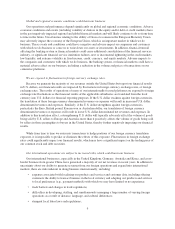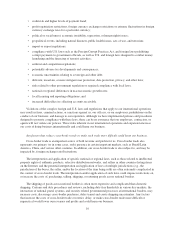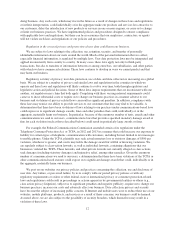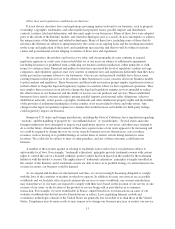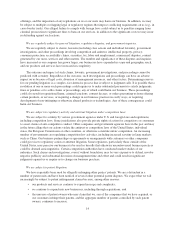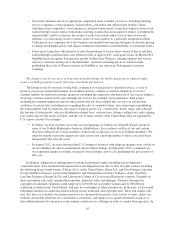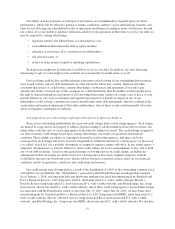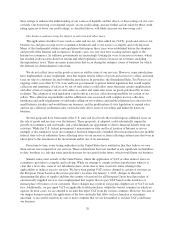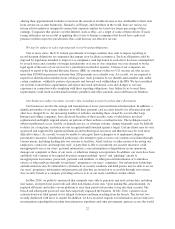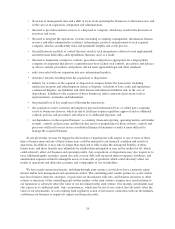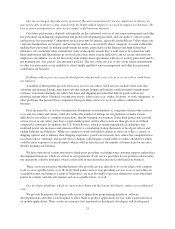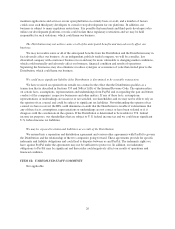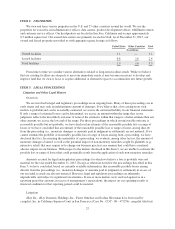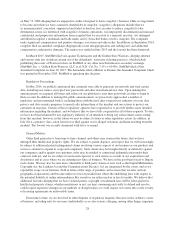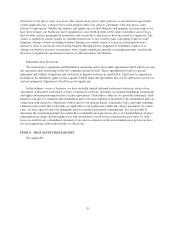eBay 2015 Annual Report Download - page 31
Download and view the complete annual report
Please find page 31 of the 2015 eBay annual report below. You can navigate through the pages in the report by either clicking on the pages listed below, or by using the keyword search tool below to find specific information within the annual report.Our ability to make payments of principal of and interest on our indebtedness depends upon our future
performance, which will be subject to general economic conditions, industry cycles and financial, business and
other factors affecting our consolidated results of operations and financial condition, many of which are beyond
our control. If we are unable to generate sufficient cash flow from operations in the future to service our debt, we
may be required to, among other things:
• repatriate funds to the United States at substantial tax cost;
• seek additional financing in the debt or equity markets;
• refinance or restructure all or a portion of our indebtedness;
• sell selected assets; or
• reduce or delay planned capital or operating expenditures.
Such measures might not be sufficient to enable us to service our debt. In addition, any such financing,
refinancing or sale of assets might not be available on economically favorable terms or at all.
Our revolving credit facility and the indenture pursuant to which certain of our outstanding debt securities
were issued contain, and any debt instruments we enter into in the future may contain, financial and other
covenants that restrict or could restrict, among other things, our business and operations. If we fail to pay
amounts due under, or breach any of the covenants in, a debt instrument, then the lenders would typically have
the right to demand immediate repayment of all borrowings thereunder (subject in certain cases to grace or cure
period). Moreover, any such acceleration and required repayment of or default in respect of any of our
indebtedness could, in turn, constitute an event of default under other debt instruments, thereby resulting in the
acceleration and required repayment of that other indebtedness. Any of these events could materially adversely
affect our liquidity and financial condition.
A downgrade in our credit ratings could materially adversely affect our business.
Some of our outstanding indebtedness has received credit ratings from certain rating agencies. Such ratings
are limited in scope and do not purport to address all risks relating to an investment in those debt securities, but
rather reflect only the view of each rating agency at the time the rating was issued. The credit ratings assigned to
our debt securities could change based upon, among other things, our results of operations and financial
condition. These ratings are subject to ongoing evaluation by credit rating agencies, and there can be no
assurance that such ratings will not be lowered, suspended or withdrawn entirely by a rating agency or placed on
a so-called “watch list” for a possible downgrade or assigned a negative ratings outlook if, in any rating agency’s
judgment, circumstances so warrant. Moreover, these credit ratings are not recommendations to buy, sell or hold
any of our debt securities. Actual or anticipated changes or downgrades in our credit ratings, including any
announcement that our ratings are under review for a downgrade or have been assigned a negative outlook,
would likely increase our borrowing costs, which could in turn have a material adverse effect on our financial
condition, results of operations, cash flows and could harm our business.
Our credit ratings were downgraded as a result of the distribution of 100% of the outstanding common stock
of PayPal to our stockholders (the “Distribution”), pursuant to which PayPal became an independent company.
As of January 1, 2014, our long-term debt and short-term funding were rated investment grade by Standard and
Poor’s Financial Services, LLC (long-term rated A, short-term rated A-1, with a stable outlook), Moody’s
Investor Service (long-term rated A2, short-term rated P-1, with a stable outlook), and Fitch Ratings, Inc. (long-
term rated A, short-term rated F-1, with a stable outlook). All of these credit rating agencies lowered their ratings
in connection with the Distribution, which occurred on July 17, 2015. Since July 20, 2015, we have been rated
investment grade by Standard and Poor’s Financial Services, LLC (long-term rated BBB+, short-term rated A-2,
with a stable outlook), Moody’s Investor Service (long-term rated Baa1, short-term rated P-2, with a stable
outlook), and Fitch Ratings, Inc. (long-term rated BBB, short-term rated F-2, with a stable outlook). We disclose
19


